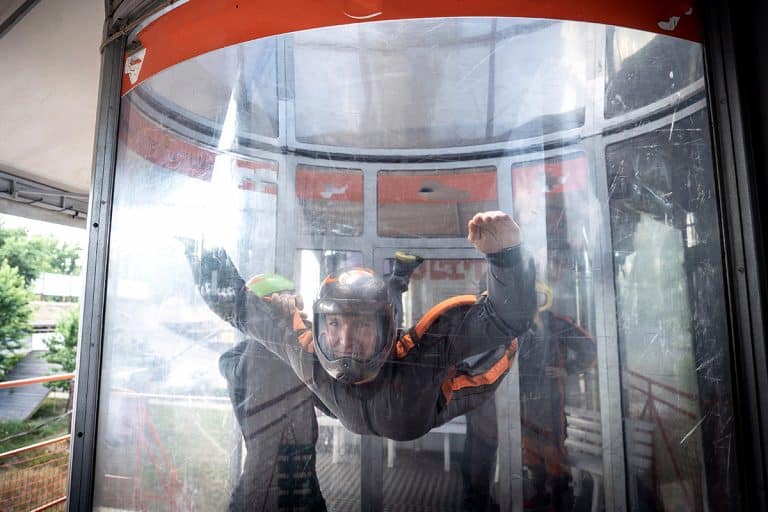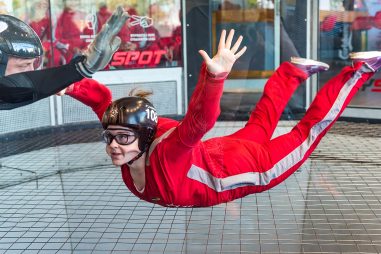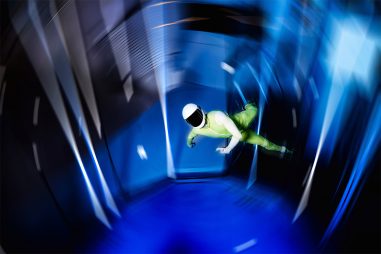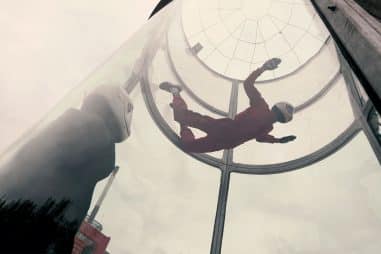You may also increase the speed if you like. However, the main difference is the adrenaline surge outdoor skydiving gives; outdoor skydiving provides a bigger thrill than indoor skydiving.
Movement and energy are combined, thus, making it a good form of exercise. Skydiving is likened to swimming, where all muscles in the body are put to use all at once. A study by Airkix (now iFLY UK) found out that 26 minutes of indoor skydiving burns 325 calories. An hour in the tunnel is about the equivalent of 60 outdoor skydives.
Is Indoor Skydiving the Same as Outdoor?
Indoor skydiving is performed in a flight chamber, and you fly in a cushion of air, while outdoor skydiving is performed by jumping from a plane in the fresh air. Physiologically, outdoor skydiving gives you more hormones because you will feel the thrill of being scared then happy towards the end.
Regarding wind speed, outdoor skydiving is faster than indoor skydiving. There is a difference of around 10-15 miles per hour (16-24 kph). Most people say that indoor skydiving is safer than outdoor skydiving because there is always an instructor guiding you, and it is performed in a tunnel. Noise is the same, but there are no earplugs for outdoor skydiving, while earplugs are provided for indoor skydiving.
Does Indoor Skydiving Help With Real Skydiving?
Indoor skydiving greatly helps with outdoor skydiving. Skydivers practice indoors in a controlled environment the optimal body position in freefall. The duration in which skydivers practice can also be lengthened with the help of indoor skydiving.
Typically, outdoor skydiving only lasts 45 – 60 seconds (depending on factors), but thanks to indoor skydiving and tunnels, you can practice for a much longer time for a fraction of the cost. Additionally, in conditions like having bad weather, indoor skydiving can be an alternative for outdoor skydiving.
How High Do You Go in Indoor Skydiving?
High flight is taking the flyer to the cylinder’s peak to experience the grandeur of indoor skydiving. A high flight is usually 10-20 feet (3-6 meters) above the net inside the cylinder.
Guests can purchase this as part of the experience, yet some indoor skydiving locations have certain conditions. This occurs in the last 15-20 seconds of the flyer’s final flight. This incredible move will let you have a superhuman experience.
How Fast Is the Wind in an Indoor Skydiving?
The average terminal velocity of wind in indoor skydiving is 120 miles an hour (193 kph). It can reach 163 mph (262 kph). This wind is similar to hurricane wind. It is made possible by an inlet contractor.
Learning how to balance and work with the wind is fundamental for stability. Wind mastery is necessary for you to perform different tricks.
Is Indoor Skydiving Good Exercise?
Indoor skydiving is a good exercise because you need to learn how to jump in the air, tighten your core, and straighten your legs. Aside from physical aspects, your mental and emotional elements are put into practice.
A term called belly flight turned to body flight, where you start with the belly progressing to complicated body flights. Back flying, sit flying, head down are maneuvers you can wave through in this exciting sport.
How Many Calories Does Indoor Skydiving Burn?
This is the formula for calories burned: Calories burned per minute = (MET x bodyweight in Kg x 3.5) ÷ 200
Here is the sample computation for calories burned:
- A person weighs 160 pounds (72.57kg) and skydives (a task that has a MET value of 3.5) for 1 hour (60 minutes total).
- Calories Burned from skydiving (per minute) = (3.5 x 72.57 x 3.5) ÷200 = 5.001
- Calories Burned from skydiving (for 60 minutes) = 4.444 x 60 = 266.64
Is Indoor Skydiving Difficult?
For first-time flyers, indoor skydiving can be challenging, but you can learn it by having instructors and proper training. Some who have experienced it say it is more complicated than it looks. Diversely, children ages three and above can enjoy this sport.
Once you have mastered skills and know-how to navigate the chamber, you can do moves like a side slide or a box slide. In addition to just flying, you can also play games inside like Quidditch, where a ball is tossed and being chased by two players.
How Do I Get Good at Indoor Skydiving?
Here are a few tips to get better and make the most out of your indoor skydiving experience:
- Know the basic proper form: Like with all sports and exercises, you must prioritize learning the correct form in the beginning before you can move on to the more complex tricks. Understanding this in skydiving can help you position your body correctly; this is especially crucial in skydiving as one wrong move can throw your body off its positioning.
- Stretching is vital: To avoid injuries, stretching is essential. Skydiving will require you to raise your arms, lift your chest, engage your core, and stretching helps to make sure you can do the full range of motion and stay injury-free.
- Supplement with exercise: The secret to learning advanced skydiving tricks? Strength training! A big part of doing tricks is stabilization which is tougher on the body than it looks. Pair your skydiving lessons with bodyweight exercises and resistance training. Also, pay extra attention to core training to help you keep your balance!





